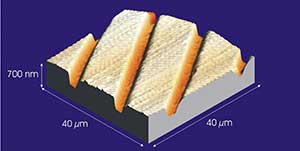Jul 11 2008
NASA's Phoenix Mars Lander has finally used the onboard atomic force microscope from Nanosurf.
 The first Atomic Force Microscope Image from Mars
The first Atomic Force Microscope Image from Mars
This Swiss-made microscope builds an image of the surface of a particle by sensing it with a sharp tip at the end of a spring, all microfabricated from a sliver of silicon. The sensor rides up and down following the contour of the surface, providing information
The first touch of an atomic force microscope tip to a substrate on the microscopy station's sample-presentation wheel served as a validation test. The substrate will be used to hold soil particles in place for inspection by the microscope. The microscope's first imaging began Wednesday and produced a calibration image of a grooved substrate. "It's just amazing when you think that the entire area in this image fits on an eyelash. I'm looking forward to exciting things to come," Hecht said.
With these developments in the past two days, the spacecraft has put to use all the capabilities of its Microscopy, Electrochemistry and Conductivity Analyzer, or MECA, suite of instruments. Researchers have begun analyzing data this week from the second sample of soil tested by MECA's wet chemistry laboratory.
Meanwhile, the Phoenix team is checking for the best method to gather a sample of Martian ice to analyze using the lander's Thermal and Evolved-Gas Analyzer, which heats samples and identifies vapors from them. Researchers are using Phoenix's robotic arm to clear off a patch of hard material uncovered in a shallow trench informally called "Snow White." They plan in coming days to begin using a motorized rasp on the back of the arm's scoop to loosen bits of the hard material, which is expected to be rich in frozen water.
More information about the use of the Nanosurf AFM in the Mars mission can be found in the AZoNano Special Feature here.